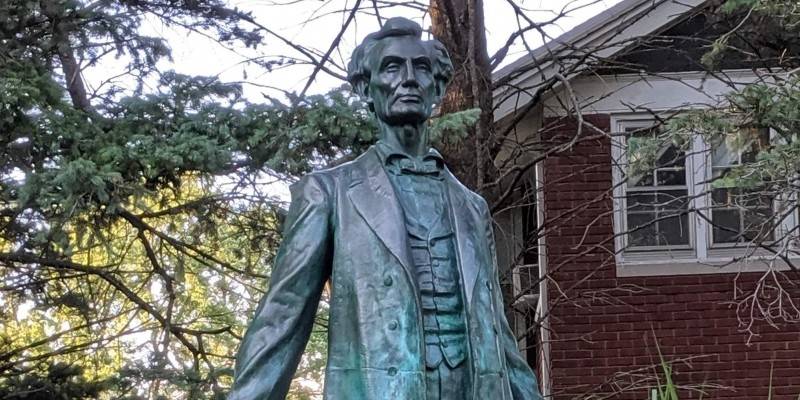As Presidents’ Day approaches, Illinoisans’ fancy turns to thoughts of Abraham Lincoln. Of course, the first part of Illinois to come to mind regarding Lincoln is Springfield, but there are a number of Lincoln historical sites in C-U and the surrounding area. If you’re willing to brave the cold and the rain, of which there has been far too much this year, you can catch some Pokémon or do some wizardry in the shadow of our sixteenth president.
In Urbana, there is a collection of Lincoln commemorative markers along Main Street. Two are located near the Champaign County courthouse, while the other is right outside Busey Bank.
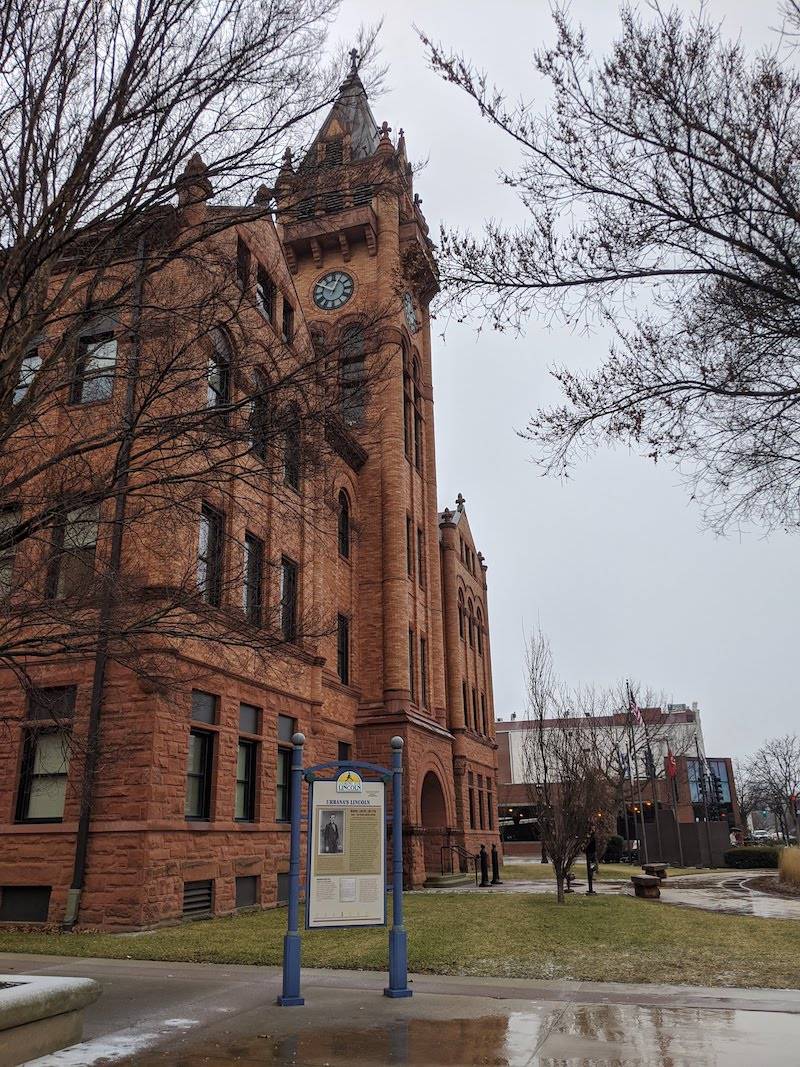
Image: The front of the Champaign County courthouse, the older portion. It has red bricks and a clock tower in the center. In front of it is an informational panel about Abraham Lincoln in Urbana. There is a grassy area in front of the building, and several trees with bare branches. Photo by Katriena Knights.
From 1847-1857, before his tenure as president, Abraham Lincoln presided over the Eighth Judicial Circuit in Illinois, which included Champaign County. As such, he made frequent stops in Urbana, Mahomet, Bloomington, Decatur, Peoria, and the other county seats that made up the fourteen-county circuit. A marker in front of the Champaign County courthouse commemorates Lincoln’s work in the circuit court.
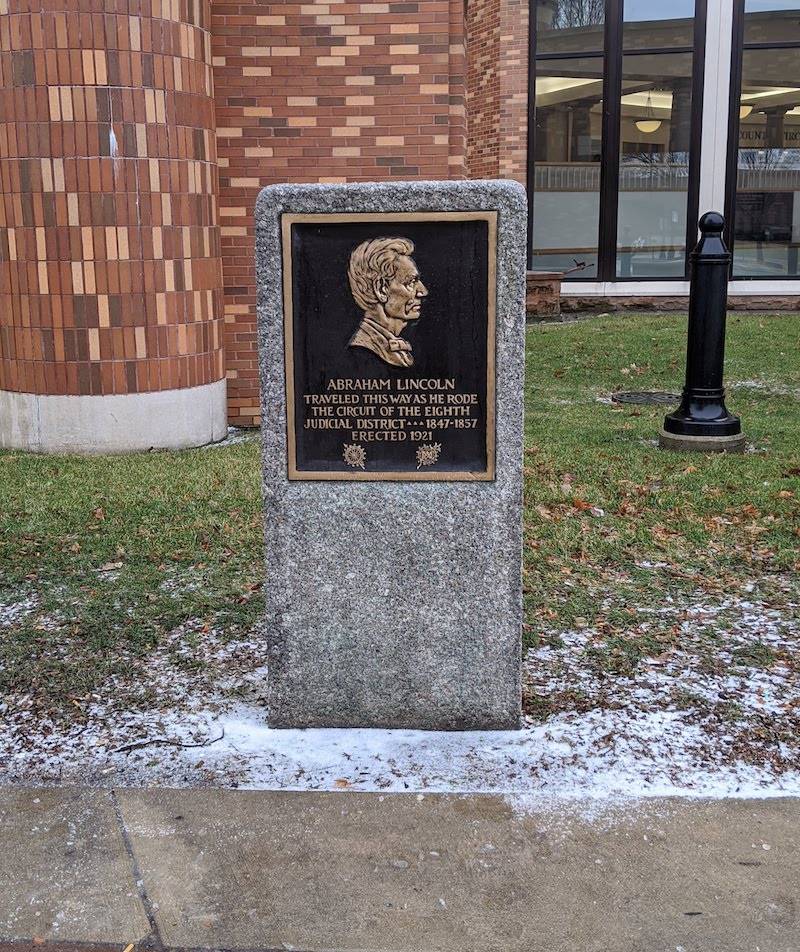
Image: A stone marker with a plaque that features the head of Abraham Lincoln in bronze, and text that says “Abraham Lincoln traveled this way as he rode the circuit of the eighth judicial district – 1847-1857. Erected 1921. Photo by Katriena Knights.
“Riding the circuit” meant that Lincoln traveled from county seat to county seat, managing cases at each stop. He would do this twice a year, and the circuit took about three months. The roads were often terrible, and the accommodations weren’t always five-star, either. However, it was during this time that Lincoln made some of the most important connections of his political career and made a name for himself as a lawyer. The standing judge who accompanied him was David Davis, who eventually became Lincoln’s campaign manager. Later, Lincoln appointed him to the U.S. Supreme Court.
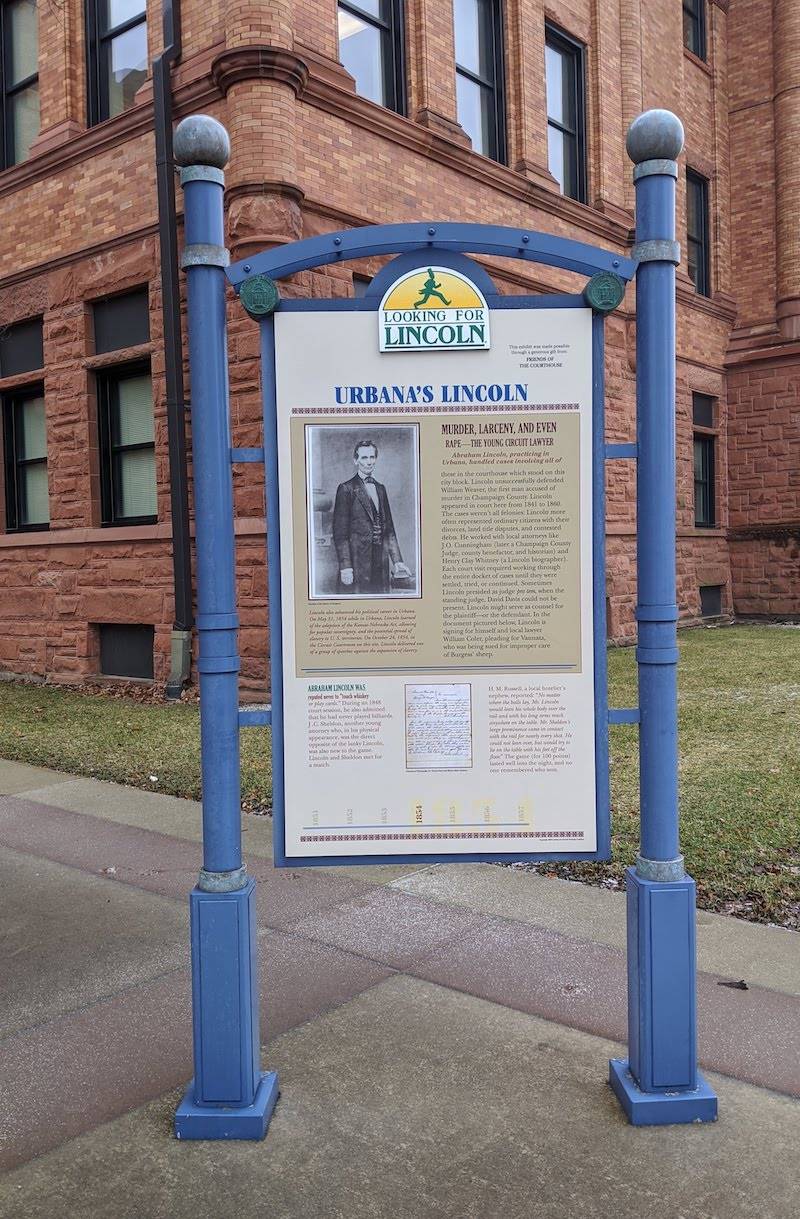
Image: A close up of an informational panel with the title Urbana’s Lincoln. It’s framed by blue posts. The courthouse is in the background. Photo by Katriena Knights.
More details about Lincoln’s exploits on the circuit court are found on the second marker near the courthouse, this one closer to the parking lot. Here, you can read about some of Lincoln’s cases, including that of the first man to be accused of murder in Champaign County, William Weaver. In spite of Lincoln’s efforts to defend him, Weaver was convicted and hanged in 1845. In 1854, Lincoln, from the Champaign County courtroom, gave one of several speeches against the expansion of slavery. These speeches, another of which was delivered in Peoria, solidified Lincoln’s stance against slavery and have been considered a turning point in his political career.
In addition to his work on the circuit court, Lincoln also served as the attorney for the Illinois Central Railroad. At the time, the railroad was the largest corporation in the state of Illinois, and Lincoln received some of the largest fees of his career representing the railroad in court, although, in the end, he had to sue them for it, as they felt he was asking too much.
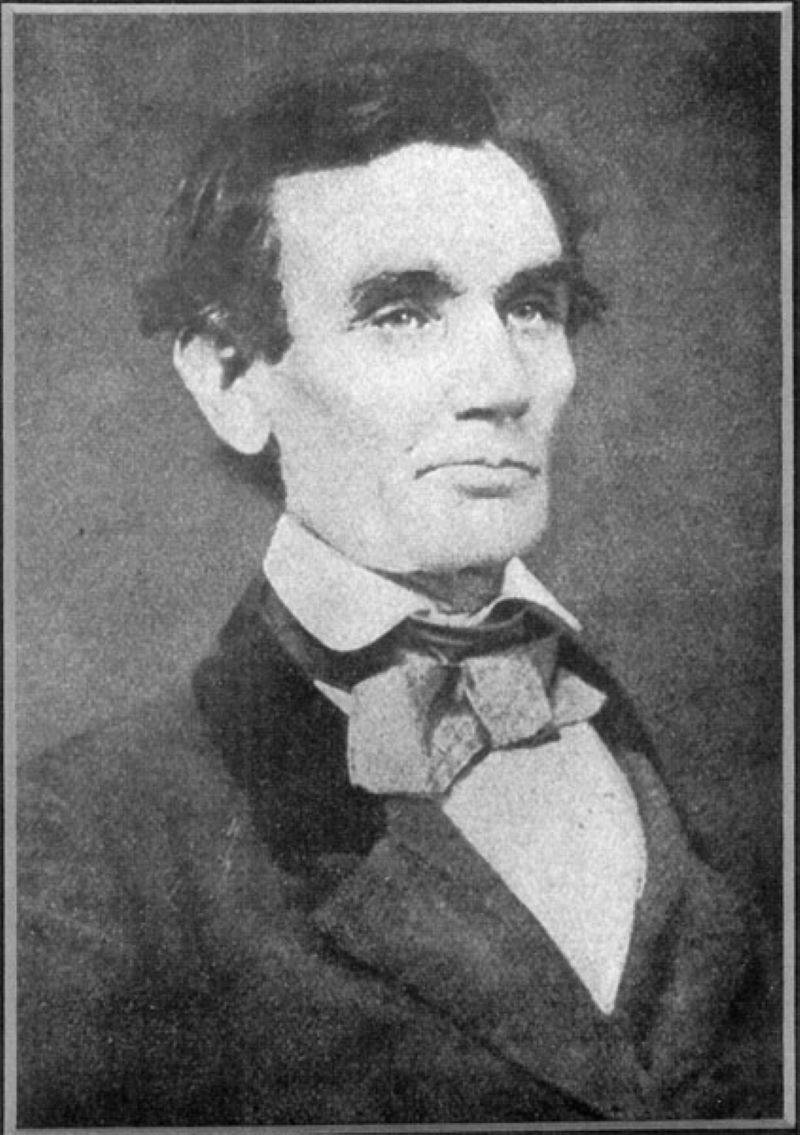
Image: A black and white photo of Abraham Lincoln. He has dark hair and no beard. He is wearing a dark suit jacket with a white shirt and light colored bow tie. Photo by Samuel Alschuler.
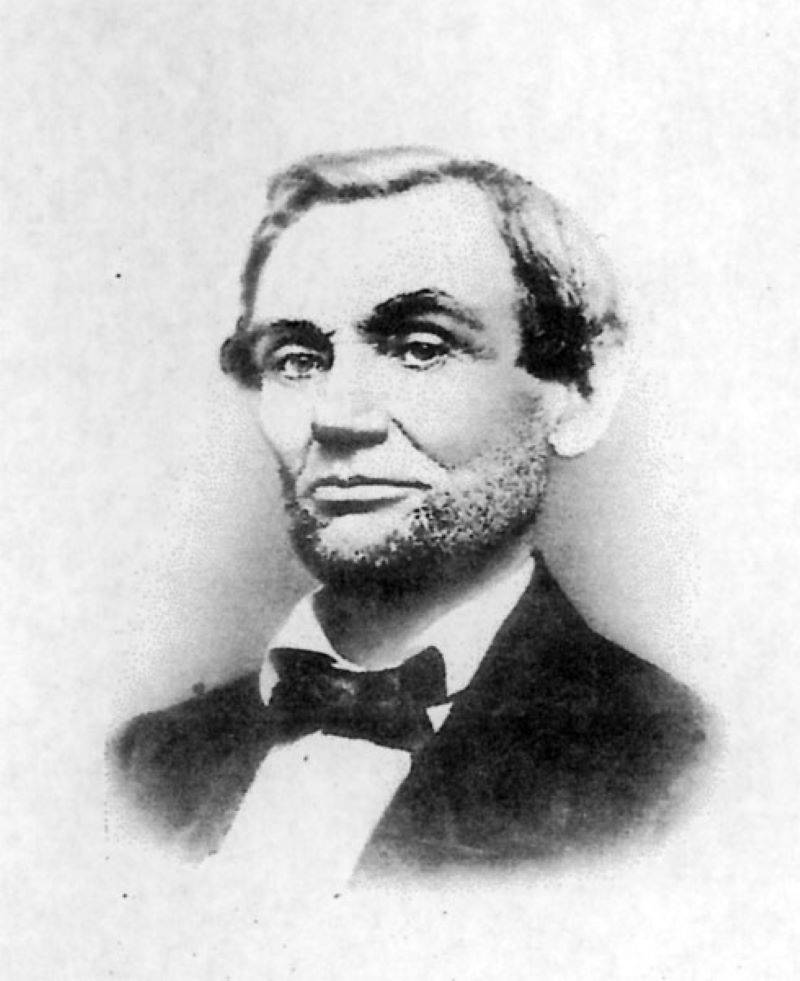
Image: A black and white photo of Abraham Lincoln. It has a white background and Lincoln is framed in a vignette. He has a beard and is wearing a dark jacket, white shirt, and dark bowtie. Photo by Samuel Alschuler.
The first of these two photos is probably familiar. It was taken in 1858 by Samuel Alschuler, a Bavarian immigrant who had set up shop as a photographer in Urbana, Illinois. Alschuler’s studio was located in the Lowenstern Building, which stood on the corner where Busey Bank is currently located (the corner of Race and Main in downtown Urbana).
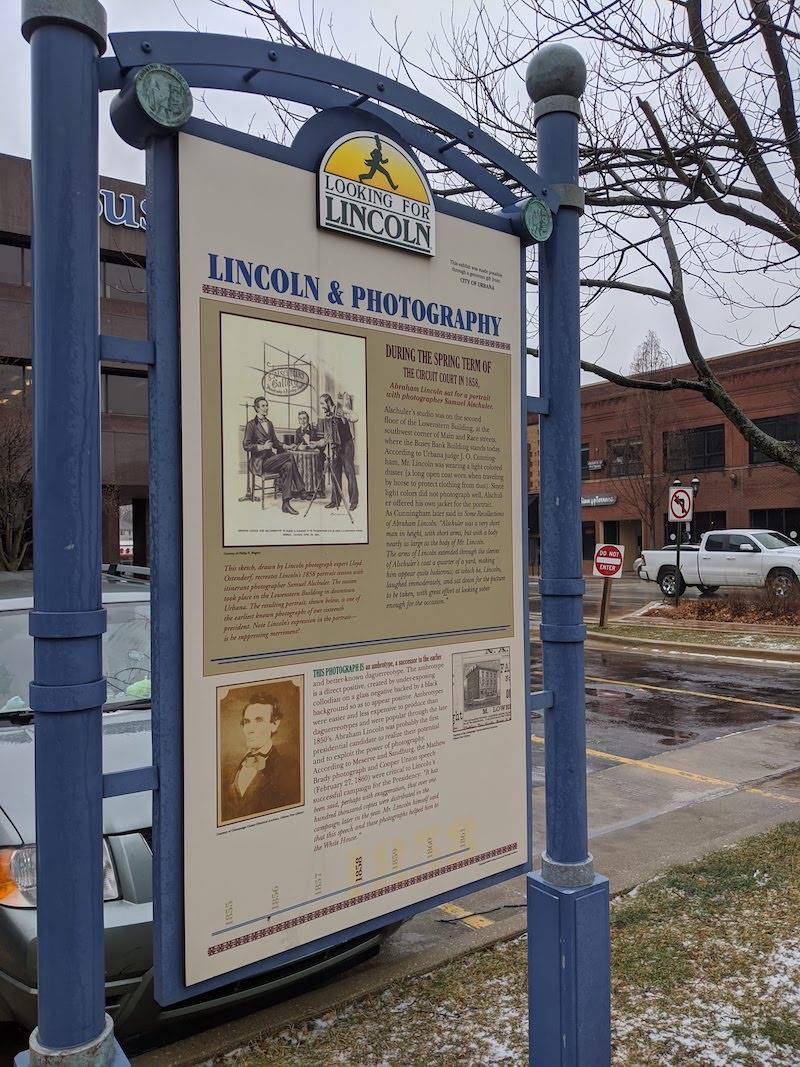
Image: An informational panel with the title Lincoln and Photography. It is framed by blue metal posts. Busey Bank is in the background. Photo by Katriena Knights.
The marker commemorating this event can be found in the grassy easement on the Race Street side of the Busey Bank building. Alschuler’s photo is one of the earliest ever taken of Lincoln. It’s notable in that Lincoln might actually be smiling — he was amused because he had squeezed himself into Alschuler’s far-too-small coat because the coat he’d worn to the photography session was light-colored, and Alschuler felt a black coat would look better in the photo.
The second photo, taken in 1860, shows the very beginning of the growth of Lincoln’s signature beard.

Image: A bronze statue of Abraham Lincoln, now green from oxidation. It is a full length statue, and the figure is leaning on a pedestal. The figure is wearing a long coat and vest. It is surrounded by overgrown grass. A house with red bricks is in the background. Photo by Katriena Knights.
Urbana is also the site of the well-known Lorado Taft sculpture, Lincoln the Lawyer, pictured above. Read more about this statue in a previous article in this series.
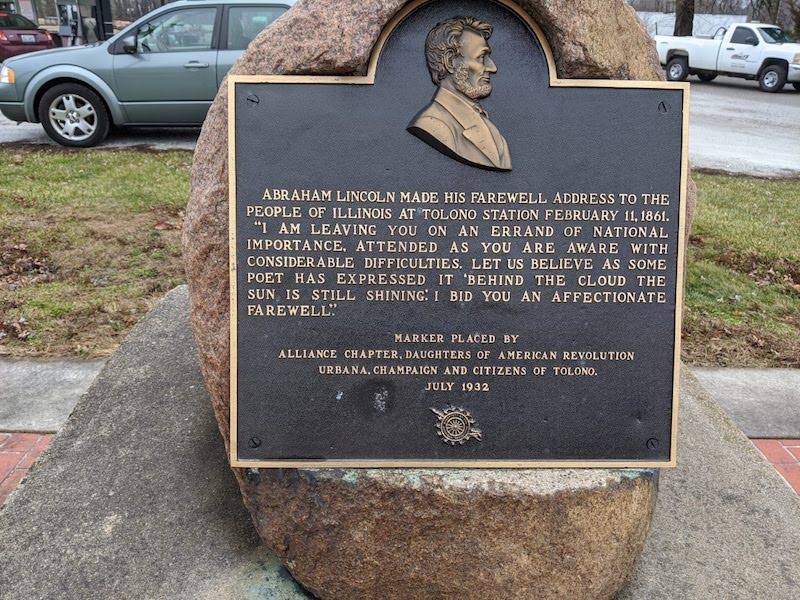
Image: A boulder with a plaque. The plaque features the bust of Abraham Lincoln and details his farewell address to the people of Illinois. Photo by Alyssa Knights.
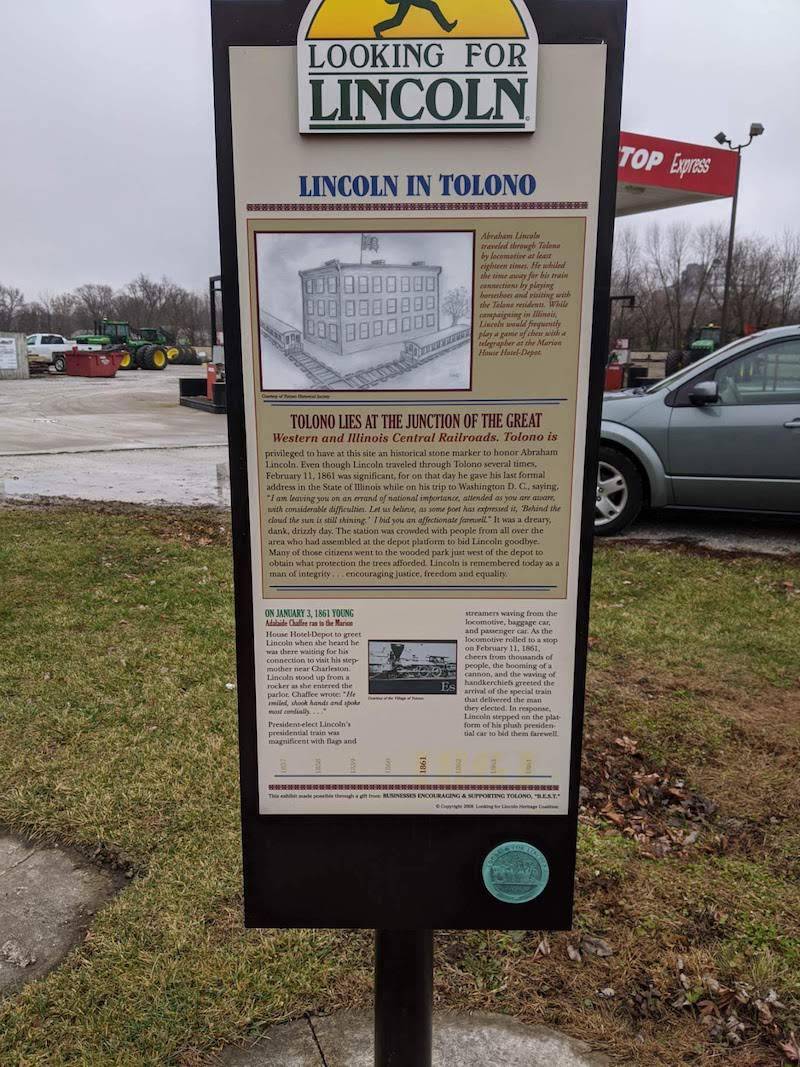
Image: An informational panel title Lincoln in Tolono. It is framed in black and surrounded by grass. Photo by Alyssa Knights.
Just a short distance south of Champaign-Urbana, on the east side of Rt. 45 and on the south edge of Tolono, is another Lincoln marker. This marker commemorates Lincoln’s frequent trips by train that led him through the town of Tolono as well as the time he spent in the small town waiting for his connections, hobnobbing with the locals, and playing chess at the depot. Most notably, Lincoln gave his last formal speech in the state of Illinois on February 11th, 1861. He made only two stops in Illinois after his departure from Springfield and his speech earlier that day. Initially, he had planned to deliver his final farewell at his stop in Danville, but so many people showed up in Tolono that he instead gave the speech from the back of the train in the Tolono station. He spoke with strong emotion about preserving the Union and about his feelings on slavery. Many in attendance, as well as friends and acquaintances, reported a deep sadness in Lincoln as he departed the state. He was, even then, receiving threats, and feared he might not live even to see his inauguration day.
Abraham Lincoln died on April 15th of 1865, the victim of an assassin’s bullet. He never returned to Illinois.
For more information on Lincoln-related historical markers in Mahomet, Decatur, Mattoon, and many other non-Springfield sites, see this link.
Top image: A bronze statue of Abraham Lincoln, now green from oxidation. The figure is visible from the waist up. The figure is wearing a coat and vest. A house with red bricks is in the background. Photo by Katriena Knights.
For Further Reading:
http://www.mrlincolnandfriends.org/eighth-judicial-circuit/
https://www.americanheritage.com/riding-circuit-lincoln
http://www.executedtoday.com/2011/06/27/1845-not-william-weaver-defended-by-abraham-lincoln/
https://www.waymarking.com/waymarks/WMHFCG_Illinois_Central_R_R_Bloomington_IL
https://www.hmdb.org/m.asp?m=31119
http://www.jewish-history.com/civilwar/alschuler.html
http://www.peorian.com/history/984-a-short-story-a-long-history-lincoln-s-farewell-to-illinois








